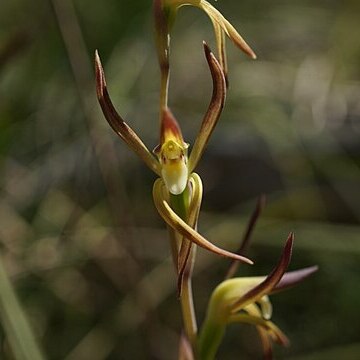Leaf narrowly lanceolate, 100–200 × 9–12 mm, dark green above, greyish beneath. Flower stem 300–450 mm tall, 2–8-flowered. Flowers 20–25 × 25–30 mm, yellowish brown, brown or dark reddish brown with a contrasting, yellow-tipped labellum. Dorsal sepal narrowly lanceolate, 20–25 × 5–6 mm, concave, hooding column, pointed. Lateral sepals linear, margins incurved, 20–25 × 2 mm, obliquely erect at base then downcurved, divergent. Petals linear, margins incurved, 20–25 × 2 mm, obliquely erect or spreading, pointed. Labellum 9–11 × 6–7 mm, curved in semicircle; lateral lobes erect, entire; midlobe blunt, bright yellow. Calli round or flat, yellow, overlapping, in dense central band, other papillae on lateral lobes. Column incurved, 7–8 × 3 mm, brownish.
More
A ground orchid. It grows in loose groups. It has a single leaf. This is narrow and sword shaped. It is 12-20 cm long by 10-12 mm wide. It is erect, stiff and leathery. It is dark green on the outside and whitish within. The flowers stem is 20-45 cm long and wiry. It has 2-8 flowers. The flowers are 2.5-3 cm across. They are greenish-yellow. They have a strong smell.

